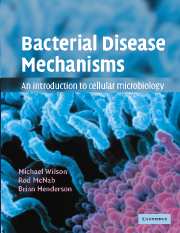Book contents
- Frontmatter
- Contents
- Preface
- Abbreviations used
- Chapter 1 An introduction to bacterial diseases
- Chapter 2 Bacterial cell biology
- Chapter 3 Molecular analysis of bacterial virulence mechanisms
- Chapter 4 Communication in infection
- Chapter 5 The mucosal surface: the front line of antibacterial defence
- Chapter 6 Immune defences against bacteria
- Chapter 7 Bacterial adhesion as a virulence mechanism
- Chapter 8 Bacterial invasion as a virulence mechanism
- Chapter 9 Bacterial exotoxins
- Chapter 10 Bacterial evasion of host defence mechanisms
- Chapter 11 Bacteria in human health and disease: the future?
- Appendix A Glossary of terms used
- Appendix B Brief descriptions of bacteria frequently mentioned
- Index
- Plate section
Appendix A - Glossary of terms used
Published online by Cambridge University Press: 05 June 2012
- Frontmatter
- Contents
- Preface
- Abbreviations used
- Chapter 1 An introduction to bacterial diseases
- Chapter 2 Bacterial cell biology
- Chapter 3 Molecular analysis of bacterial virulence mechanisms
- Chapter 4 Communication in infection
- Chapter 5 The mucosal surface: the front line of antibacterial defence
- Chapter 6 Immune defences against bacteria
- Chapter 7 Bacterial adhesion as a virulence mechanism
- Chapter 8 Bacterial invasion as a virulence mechanism
- Chapter 9 Bacterial exotoxins
- Chapter 10 Bacterial evasion of host defence mechanisms
- Chapter 11 Bacteria in human health and disease: the future?
- Appendix A Glossary of terms used
- Appendix B Brief descriptions of bacteria frequently mentioned
- Index
- Plate section
Summary
ABC transporter. One of a family of transporter systems with common molecular architecture. The hydrolysis of ATP drives the import/export of substrates.
Accessory cells. Immune cells that form part of immune defences but are not antigen specific. Examples include mast cells, natural killer cells and phagocytes.
Acidophile. An organism that prefers an acidic environment for growth.
Aciduric. An organism that can survive exposure to low pH values.
Acquired immunity. As opposed to innate immunity. The immunity generated only after an individual has been exposed to a pathogen (or specific immunogen).
Actin filaments. Key components of the cytoskeleton of eukaryotic cells.
Acute disease (infection). A disease (infection) that lasts only a short period of time.
Acute phase proteins. A group of proteins including C-reactive protein (CRP) and serum amyloid protein (SAP) that have opsonic and other actions against bacteria and protozoans.
Acute phase response. Part of the innate defence mechanism against pathogens. Refers largely to the induction of a group of proteins that can increase in concentration, in the blood, by up to three log orders.
Acylation. The attachment of a lipid molecule to a protein.
Adapter proteins. In cell signalling – proteins that act to connect one cell signalling protein with another, thus allowing passage of the signal.
Adenocarcinoma. Malignant growth of endocrine (glandular) tissue.
Adenylyl cyclase. Enzyme responsible for synthesis of cyclic AMP (c-AMP).
Adhesin. The particular molecule (or part of the molecule) on a bacterium (usually on one of its organelles) that is responsible for mediating adhesion of the organism to a host cell, to another bacterium or to an inanimate surface.
- Type
- Chapter
- Information
- Bacterial Disease MechanismsAn Introduction to Cellular Microbiology, pp. 615 - 632Publisher: Cambridge University PressPrint publication year: 2002



